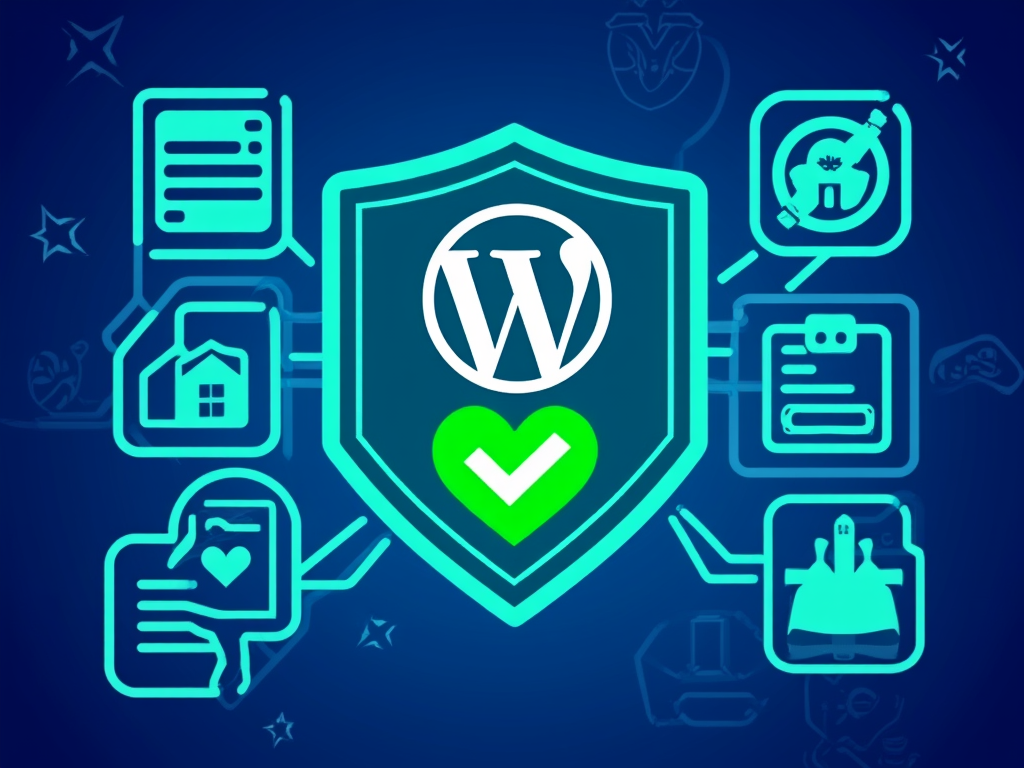WordPress Security: Essential Tips
1. Introduction
In today’s digital landscape, WordPress security is more critical than ever. Over 40% of websites are powered by WordPress, making it a prime target for hackers eager to exploit vulnerabilities. Whether you are a passionate blogger or managing a corporate site, the need for robust security is paramount. Protecting sensitive data, maintaining user trust, and ensuring seamless operations are cornerstones of a well-functioning website.
As we navigate the intricate web of security measures, we will explore the essential tips that can safeguard your site from malware, brute force attacks, and data breaches. With a blend of actionable steps, recommended tools, and real-world examples, you are about to embark on a journey toward fortifying your online presence in 2025.
2. Main Section
2.1. Core Security Practices
The foundation of a secure WordPress site is built upon a series of core practices. Implementing these simple yet effective measures can drastically reduce the risk of a security breach.
- Keep WordPress, Themes, and Plugins Updated
Regular updates are crucial as they often include patches for known vulnerabilities. Outdated software is among the most common points of entry for hackers.- Action Steps:
- Enable automatic updates for the WordPress core, themes, and plugins.
- Regularly check for updates in your WordPress dashboard.
- Remove unused plugins and themes to minimize exposure.
- Action Steps:
- Use Strong Passwords and Two-Factor Authentication (2FA)
Weak passwords continue to be a leading cause of security breaches. With 80% of hacking attempts involving compromised or weak passwords, it’s time for a change.- Action Steps:
- Utilize a password manager to generate and store complex passwords.
- Enable 2FA for all user accounts, employing plugins like Google Authenticator and Wordfence Security for easy setup.
- Action Steps:
- Limit Login Attempts
Brute force attacks are a prevalent threat, where hackers try countless combinations to gain access. Limiting login attempts offers a layer of defense.- Action Steps:
- Install a plugin such as Limit Login Attempts Reloaded.
- Set reasonable limits (i.e., five attempts) before locking out an IP address.
- Action Steps:
- Disable File Editing in the WP Dashboard
Allowing direct edits to PHP files increases risk. An attacker gaining access can wreak havoc.- Action Steps:
- Add this line to your
wp-config.phpfile:
define('DISALLOW_FILE_EDIT', true);
- Add this line to your
- Action Steps:
- Activate an SSL Certificate
SSL (Secure Sockets Layer) encrypts data, protecting sensitive information shared between your site and users.- Action Steps:
- Use a reputable hosting provider that offers free SSL certificates (like Bluehost or WP Engine).
- Ensure your site operates under HTTPS across all pages.
- Action Steps:
- Regularly Back Up Your Site
Regular backups serve as your safety net against breaches or data loss.- Action Steps:
- Employ backup plugins like UpdraftPlus or BackupBuddy.
- Schedule automatic backups and store them offsite to ensure redundancy.
- Action Steps:
2.2. Advanced Security Measures
Once you’ve established the core practices, consider these advanced measures to elevate your site’s security further.
- Install a Reputable Security Plugin
Security plugins bundle various features designed to shield your site from threats.- Top Plugins:
- Wordfence Security: Real-time protection, malware scanning, and built-in firewall.
- Sucuri Security: Renowned for malware detection and monitoring.
- Solid Security Pro: Offers file integrity monitoring and security hardening presets.
- Action Steps:
- Select a plugin that aligns with your needs and budget.
- Regularly audit the plugin’s settings and logs.
- Top Plugins:
- Monitor User Activity and File Changes
Observing user activity can facilitate instant detection and response to unusual behaviors.- Action Steps:
- Implement audit trail plugins like WP Activity Log.
- Activate file integrity checks in your security plugin.
- Action Steps:
- Use a Web Application Firewall (WAF)
A WAF filters and blocks malicious traffic before reaching your site.- Action Steps:
- Many security plugins integrate a WAF (e.g., Wordfence, Sucuri).
- Consider a cloud-based WAF like Cloudflare for enhanced protection.
- Action Steps:
- Restrict Access to Sensitive Files
Safeguarding files such aswp-config.phpis vital; unauthorized access can lead to disastrous outcomes.- Action Steps:
- Implement file permission controls and routinely review them.
- Action Steps:
- Scan for Malware and Security Issues
Routine scans are essential to spot and eliminate malware before significant damage ensues.- Action Steps:
- Utilize your security plugin for regular scans.
- Act promptly on results, evaluating and resolving issues discovered during scans.
- Action Steps:
- Use WordPress’ Site Health Checker
This built-in tool conducts checks on potential security issues.- Action Steps:
- Access the Site Health Checker through WordPress Admin.
- Address any flagged issues diligently.
- Action Steps:
2.3. Professional Context and Localized Examples
In the realm of business, the ramifications of a security breach escalate. A compromised site can lead to catastrophic data loss, financial fallout, and irreparable reputational damage. Take, for instance, a small e-commerce site in the UK; it fell victim to hacking due to an outdated plugin, resulting in stolen customer data and a significant decline in sales.
- Action Steps:
- Conduct regular security audits.
- Implement a training program on security best practices for staff.
- Prepare a security incident response plan.
Locally, a community news website in the US recently faced a DDoS attack. Thanks to a combination of a WAF and a vigilant hosting provider, they mitigated the assault and maintained uninterrupted service for their readers.
- Action Steps:
- Select a hosting provider that emphasizes security features.
- Employ a WAF to filter out harmful traffic efficiently.
2.4. Visual Elements
| Plugin Name | ძირითადი მახასიათებლები | Pricing (Free/Premium) | საუკეთესოა |
|---|---|---|---|
| Wordfence Security | Malware scanning, firewall, 2FA | Free / $149/year | Strong, server-level security |
| სუკურის უსაფრთხოება | Malware detection, WAF, cleanup | Free / $299.99/year | Malware protection, monitoring |
| Solid Security Pro | File integrity, login limits, hardening | Free / $99/year | Beginners, easy setup |
| All-In-One Security | Security auditing, monitoring, firewall | Free / $70/year | Comprehensive security |
As cyber threats continue to evolve, staying ahead involves following new strategies, making necessary updates, and understanding the unique challenges your site faces. The world of WordPress security is not static; it demands attention, adaptation, and ongoing vigilance.
საუკეთესო შეთავაზებები:
გსურთ შექმნათ თქვენი საკუთარი კომპანიის ვებსაიტი ან შექმნათ თქვენი საკუთარი ონლაინ ბიზნესი ინტერნეტში?
– ვებ ჰოსტინგი
– დომენის რეგისტრაცია
– ვებ-განვითარება
– საიტის შემქმნელი



and security practices, consider watching these informative videos:
- WordPress-ის უსაფრთხოების საუკეთესო პრაქტიკა
- How to Secure Your WordPress Site
- Understanding SSL Certificates and HTTPS
- Creating a WordPress Security Plan
By integrating these practices, keeping yourself updated, and empowering your team, you set the stage for a secure WordPress environment that protects both you and your users from potential threats. Remember, security is not just about technology; it’s a multifaceted approach involving policies, people, and practices. Stay informed, stay safe, and your WordPress journey can flourish without the looming threat of security breaches.
FINDDOMAIN.GE (შპს ინტერნეტ სერვისები) ძალიან საინტერესო და სწრაფად განვითარებადი IT კომპანიაა. ძირითადი მიმართულებებია: ვებ-განვითარება, დომენები და ვებ-ჰოსტინგი. ის ასევე სთავაზობს კლიენტებს ძირითად სერვისებთან დაკავშირებულ ქვე-მომსახურებას და აუთსორსინგს.
საუკეთესო შეთავაზებები:
გსურთ შექმნათ თქვენი საკუთარი კომპანიის ვებსაიტი ან შექმნათ თქვენი საკუთარი ონლაინ ბიზნესი ინტერნეტში?
– ვებ ჰოსტინგი
– დომენის რეგისტრაცია
– ვებ-განვითარება
– საიტის შემქმნელი








